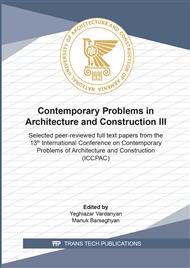[1]
Glukhovsky V.D. Slag-alkali binders and concretes. Kiev. Bugivelnik, 1978 - 280s.
Google Scholar
[2]
Sahakyan E.R. New artificial cellular materials, lightweight aggregates and products based on them. Doc. of Tech. Sci. MHTI named after D.I. Mendeleev, 1992 - 394p.
Google Scholar
[3]
R.A. N3286. Sahakyan E.R., Arzumanyan A.A., Cellular glass and a method for its production, (2019).
Google Scholar
[4]
Yazichyan R.N. Chemically resistant silicate building materials based on volcanic rocks. Doctor of Technical Sciences Yerevan Polytechnic Institute, 2002 - 117p.
Google Scholar
[5]
Falkman V.R., Okhotnikova K.Yu., Geopolymer binders and concretes in modern construction. ISSN 2227-6017 (ONLINE), ISSN 2303-9868 (PRINT),.
Google Scholar
[6]
Alkali Activated Materials. Ed. By Provis I.L., van Deventer I.S.I., Springer, 2014 - 388p.
Google Scholar
[7]
Eroshkina N.A., Korovkin M.O., Resource and energy saving technologies of building materials materials based on mineral-alkaline and geopolymer binders, Penza: PUGAS, 2013 - 156p.
Google Scholar
[8]
Kitaigorodsky I.I., Keshityan T.N., Foam glass, Promstroyizdat, 1953 - 77p.
Google Scholar
[9]
Schill F., Foam Glass, Styroizdat. M. 1982 - 375s.
Google Scholar
[10]
Demidovich B.K., Foam glass., Minsk: Science and Technology, 1975 - 247p.
Google Scholar
[11]
A.S. USSR N292909 Charge for the manufacture of foam glass, Authors: M.V. Darbinyan, E.R. Sahakyan, 1971, Vol. N5.
Google Scholar
[12]
Darbinyan M.V., Sahakyan E.R., Obtaining porous materials and products of foam glass from rocks // Industry of Armenia N12, 1966, pp.47-48.
Google Scholar
[13]
Sahakyan E.R., Multifunctional cellular glass from volcanic glassy rocks // Glass and ceramics, 1991, N1, pp.5-6.
Google Scholar
[14]
Sahakyan E.R., Cellular glass from sedimentary siliceous rocks // Glass and ceramics, 1991, N3, pp.3-4.
Google Scholar
[15]
Sahakyan E.R., Cellular glass and granulate from the Trans-Baikal perlite glass // Glass and ceramics, 1990, N2, p.7.
Google Scholar
[16]
Patent RA N3286A / Cellular glass and a method for its production. Authors: E.R. Sahakyan, A.A. Arzumanyan, (2019).
Google Scholar
[17]
Yazichyan R.N., Optimization of technological parameters of acid-resistant glass conglomerate of low-temperature sintering // Chemical Journal of Armenia, -2000, v.53, v 3-4, pp.111-117.
Google Scholar
[18]
Yazychian R.N., // Chemically resistant silicate building materials based on volcanic rocks. Abstract of Candidate of Technical Sciences EPI 2020, -21p.
Google Scholar
[19]
Sahakyan E.R., Andreasyan M.K., Yazichyan R.N., Chemically resistant stoneware ceramics // Glass and ceramics, 1997, N7, pp.18-19.
Google Scholar
[20]
A.S. USSR N380623, Mass for the manufacture of heat-insulating material, E.R. Sahakyan, G.G. Hakobyan, N.V. Mesropyan, 1973, Bull. N21.
Google Scholar
[21]
A.S. USSR N684028, Composition for the manufacture of heat-insulating material, E.R. Sahakyan, G.G. Akopyan, N.V. Mesropyan, 1979, Bull. N33.
Google Scholar
[22]
A.S. USSR N730651, Ramming compound for thermal insulation of hot surfaces, E.R. Sahakyan, G.G. Hakobyan, N.V. Mesropyan, 1980, Bul. N16.
Google Scholar
[23]
Emma Sahakyan, Artavazd Arzumanyan, Nelli Muradyan // Physical and Chemical processes of volcanic rock hardening / IOP Conf. Series: Materials Science and Engineering 698 (2019) 022078.
DOI: 10.1088/1757-899x/698/2/022078
Google Scholar
[24]
N.Muradyan Determination of technological characteristics of cementless stone production from the waste of volcanic rock extraction// NUACA Bull. N2, 2020 pp.92-108.
Google Scholar
[25]
Nasedkin V.V., Petrogenesis of felsic volcanics, Moscow: Nauka, 1975, 304s.
Google Scholar
[26]
Saakyan E.R., Reactions in mixtures of aluminosilicates with sodium hydroxide and their thermodynamics, Tr. Scientific Research Institute of Stone and Silicates, vnp. 8, Yerevan 1975 from 209 - 212.
Google Scholar
[27]
Saakyan E.R., Frenkel B.N., Matveev G.M. Thermodynamic analysis of reactions in mixtures of quartz with sodium hydroxide // Journal of Applied Chemistry, Leningrad, vol. XLVI, c 2421 – 2424, (1973).
Google Scholar
[28]
Ginstling A.M. Granulometric composition of solid mixtures and the process of its chemical transformation / Coll. Scientific works on the chemistry and technology of silicates, -M.:1956 - p. 2b.
Google Scholar
[29]
O.P. Mtschedlow - Petrossian, E.R. Saakian. Zur Frage oler. Blähfähigkeit glasartig erstarrter vulkanisches. Gesteine// Silikattechnik, 39 (1988), Heft 6, - 189 – 190s.
Google Scholar
[30]
Sahakyan E. R. New artificial cellular materials, lightweight fillers and products based on them. Author's abstract. dis. so-called M: Moscow Art Theater. D. I. Mendeleev, (1992).
Google Scholar


